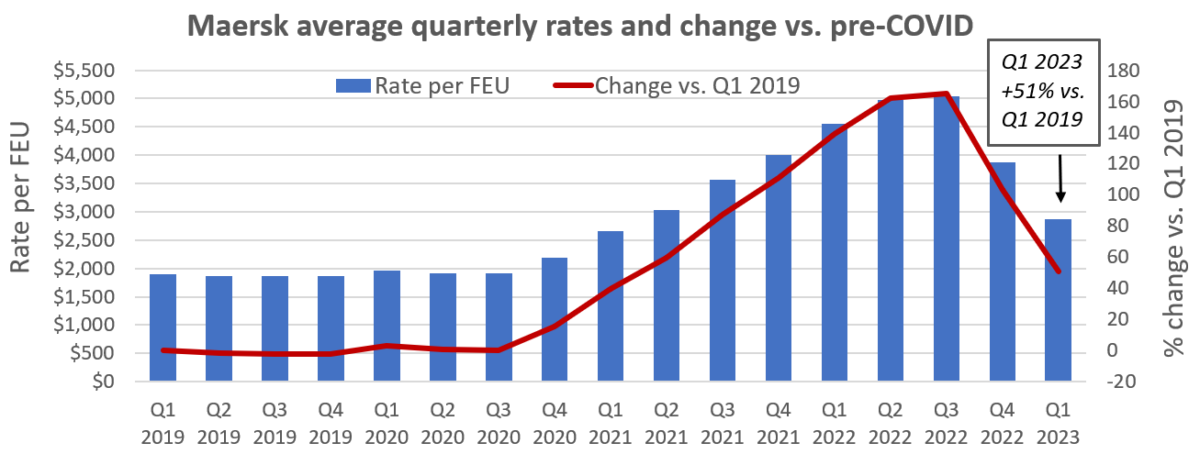Pain during shipping downturns is often self-inflected by the industry itself. A scramble for market share spurs a rate spiral; too many ship orders compound the losses. Maersk CEO Vincent Clerc maintained on Thursday’s conference call that liners are avoiding at least some of these self-inflicted wounds.
Clerc said ocean carriers are managing capacity fairly well, demand is primarily down due to temporary inventory overhangs, and margins remain higher than pre-COVID levels.
Maersk’s first-quarter results came in better than expected. Its adjusted earnings before interest, taxes, depreciation and amortization was $4 billion. The Bloomberg analyst consensus was $3.5 billion. Earnings before interest and taxes (much closer to net income than EBITDA) was $2.3 billion, topping analyst projections for $1.9 billion.
Despite all the turmoil since Maersk gave its initial full-year guidance in February, the company kept its outlook unchanged on Thursday. It still expects full-year EBITDA of $8 billion-$11 billion and EBIT of $2 billion-$5 billion.
The general message from the world’s second largest container line operator: Market normalization is proceeding as anticipated.
“The 2023 contract negotiations season progressed as expected,” said Clerc, noting that 75% of Maersk’s contracts for this year are now concluded globally. “We are signing contracts trending toward — but still above — spot rates.” Contract rates in the trans-Pacific market, which went into effect at the beginning of this month, “closed pretty much as we expected.”
The big question, he said, is when the inventory destocking phase will be complete. Maersk continues to predict it will end at some point in the second half, leading to higher volumes — but it sees no evidence of it ending yet.
“Based on purchase orders we see through our 4PL [fourth-party logistics] activities, we do not yet observe a consistent pickup of volume trending into Q2,” said Maersk CFO Patrick Jany.
According to Clerc, “Inventory destocking has been the red thread of this cycle. These circumstances are temporary in nature. Whether they last seven months, eight months, 10 months — or more — that’s the part that’s really, really hard for us to predict.
”We don’t have data from our 4PL that this is coming to an end right away, but we can clearly see that what is being moved is significantly below consumption. It’s the inventory that makes up the difference.”
‘We definitely see better conduct’
Clerc maintained that liner companies are behaving rationally in terms of current capacity management, although not necessarily on the newbuilding front.
Maersk implemented slow steaming in Q1 2023, significantly lowering fuel costs, and “blanked” (canceled) sailings to manage capacity. Other carriers did as well, said Clerc. Liners have “dusted off the old playbook that we have successfully used before.”
Maersk’s Q1 2023 utilization rate was 88% of offered capacity, compared to 91-92% in a typical strong market. “By blanking sailings we’re making sure we adjust our network to the size of the demand and that we don’t sail with lower utilization,” said Clerc.
“The stabilization of rates you saw in the first quarter could not have been possible if it was only Maersk behaving in a rational way,” he continued. “We have seen significant blanking activities [by competitors] … and more rational behavior [than in past downcycles]. We definitely see better conduct.
“If you look at the downcycles in connection with the financial crisis in 2008-09 and the one in 2015-16, the market adjusted all the way down and had to rebound to find a balance. In this case, the market went down and then found a balance without having to go all the way down and hit the bottom.”
The next test for liner behavior will come in the second half, when higher-priced contracts signed last year have all rolled off and some — possibly many — liners will be in the red.
“In the past we have seen some irrational behavior,” said Clerc. “Let’s see in the second part of the year whether this happens or not.”
The colossal newbuilding orderbook poses yet another industry test, he acknowledged. “On the operational side, there’s a lot more rationality. On the ordering [side], there is a concern about the level of ordering and what needs to be phased in during 2023 and 2024. There are risks on how they are going to be phased in.”
Maersk’s rates still 51% higher than pre-COVID
The key driver of Maersk’s — and all container lines’ — profitability is average freight rates, based on the mix of contract and spot. In Maersk’s case, 70% of all 2023 volumes (and 71% of east-west mainline volumes) will be under contracts.
According to Jany, Q1 2023 “will represent the peak quarter of the year.” He explained, “The progressive erosion of contract rates toward spot levels will be the main element determining profitability in the next quarters.”
Maersk reported average spot rates of $2,871 per forty-foot equivalent unit in Q1 2023, down 37% year on year and 26% quarter on quarter — but still up 51% versus Q1 2019, pre-COVID.

Net income was $2.3 billion in Q1 2023, plunging 66% from $6.8 billion in Q1 2022.
According to Clerc, “The numbers are significantly below the prior year’s, but in the wider context, compared to our pre-pandemic performance, this is still an outstanding quarterly result.”

Click for more articles by Greg Miller
Related articles:
- Container shipping warning: Green shoots are ‘transitory illusion’
- As Asia-US shipping rates rise, so does skepticism on staying power
- Container shipping sees signs of a bottom (at least, for now)
- Mixed signals: Container shipping downturn not following the script
- How much will container lines ‘earn’ in 2023? It depends on the metric
- ‘Colossal’ tidal wave of new container ships about to strike
- Maersk: Container shipping contract rates will sink to spot levels







